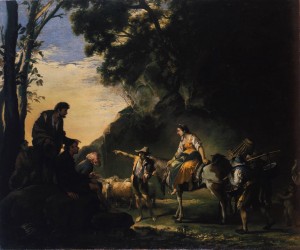CLASS: BONE DEEP GOTHIC
Curious what this is all about? Find out here!
Salvator Rosa was born in 1615 in the Arenella quarter of Naples.
This was long prior to the establishment of Italy as a nation, yet after the Renaissance age of autonomous city-states, and fell during a period of external domination by other European powers.
The Italian Wars of the 16th century had involved not only the great city-states of Italy (Rome, Milan, Venice, Florence, and Naples), but France, Spain, the Holy Roman Empire, England, Scotland, and the Ottoman Empire… it was a time of complicated dynastic feuds and emergent nationalism. It was also a time of recurrent plague, raids and overlapping wars, banditry throughout the countryside, and, in Naples, the looming threat of Mount Vesuvius, which erupted in 1631. Regionally, Italy was in the midst of a long political and economic decline.
Ultimately, the Spanish branch of the Habsburg family prevailed in the war, and so southern Italy was ruled from a much-resented Spain as the Viceroyalty of the Two Sicilies. The “Two Sicilies” referred to in the name are the kingdoms of Naples and of Sicily. Naples itself had long been the crown jewel of southern Italy, and had a longstanding reputation for sybarite indulgence, as well as high culture in the midst of spectacular natural surroundings.
These were a few of the historical circumstances into which Salvator Rosa was born to a Greek mother and a Neapolitan land surveyor.
Six years later, after a long illness, Rosa’s father died, leaving the family in poverty. Rosa’s mother remarried in 1625 and her children eventually came under the guardianship of their grandfather. The family was not wealthy by any means and Rosa’s education was administered at a charitable school run by a Piarist order. Although Rosa had been urged early on toward a profession in law or the Church, he leaned toward the arts, partly thanks to the influence of successful painters on his mothers’ side and his liberal (for the time) Piarist education.
Rosa gained access to the unique world of the Italian studio through his sister’s 1832 marriage to the artist Francesco Fracanzano. Accounts of Rosa’s training differ, but he is thought to have studied with Aniello Falcone and Jusipe de Ribera. Langdon’s biography supports a close relationship with Ribera, a well known Spanish painter known locally as “Lo Spagnoletto.” As Rosa trained in these studios, he painted landscapes, street scenes, and scenes from Bible and the lives of the saints.
Despite his early poverty, Rosa sold some of his early work to well-known painters, and moved frequently between Naples and Rome, where he was able to pursue connections with art collectors in the Papal government. One such patron, the Cardinal Brancaccio, was to be Rosa’s most loyal lifelong supporter. Rosa did paintings in the emerging field of landscape painting, but his early work also had affinities with Pieter van Laer or Il Bamboccio, the “little clumsy one.” Painting along the lines of van Laer, which was popular at this time, took on “low” subjects such as street scenes and the lives of the urban poor. It was a style Rosa would later hold in contempt, although it defined many of his early successes. His early work (c. 1840) Landscape with Travelers is considered to be a typical example.

Rosa wasn’t just a painter during this time, either. He was known in the studios as being a “spontaneous wit” and a “lively character” (Langdon 14), with a fierce passion for fame and an inclination toward bizarre and dramatic subjects. Rosa’s connection with Brancaccio also put him in touch with some of the dramatic and satiric companies that defined cultural life in Italy at the time. Langdon writes: “At the carnival of 1639, Rosa delighted all Rome with his appearance as Pascariello, a Neapolitan mask whose language and gestures captivated the Romans; he and his masked friends went round the streets of Rome, parodying the acts of the charlatans, and handing out fake prescriptions.” Rosa’s successful performances led him to attack a rival troupe headed by famed sculptor Gianlorenzo Bernini and playwright Ottavio Castelli. It’s difficult for us to understand today the seriousness of such artists’ disputes, which sometimes resolved with exile or even murder. Much was at stake, as Italian artists lived and died by their reputations, which connected them to their wealthy and politically powerful patrons. Significantly, it wasn’t long after this dispute that Rosa accepted an invitation to work in Florence for a time.
Sources:
Helen Langdon, Salvator Rosa
Richard Davenport-Hines, Gothic
Reference articles can be easily found on the Italian Wars, the History of Italy, the History of Naples, Salvator Rosa, etc.
